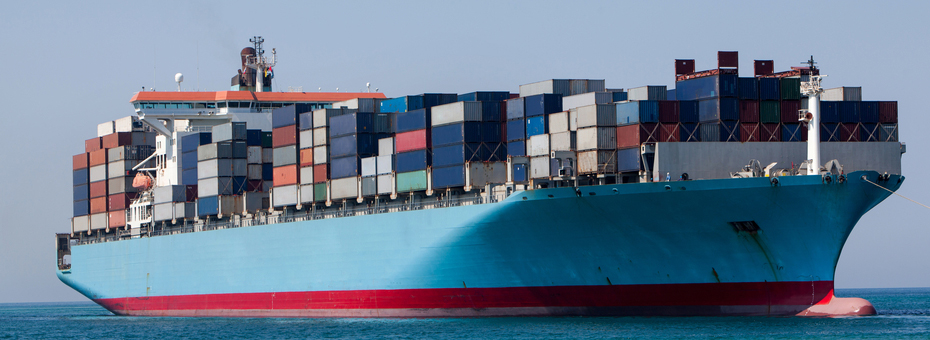It’s commonplace nowadays to remark that lean has spread to many industries beyond manufacturing. What’s sometimes surprising is where it has not taken hold. Take the ocean transportation industry, for example. Transportation, when unnecessary, is a major cause of waste, so you’d think leaders in such an industry would not have to look far to find literally boatloads of muda to eliminate.
Unfortunately, the container shipping industry suffers from the same flaw in its thinking as airlines: Namely, that maximizing asset utilization should be the main goal of the company’s operations. When I worked in the industry, from 2001 to 2014, management had no keener eyes than those for the weekly utilization figures. And yet paradoxically the largest container shipping companies have, over the course the last 5-6 years, invested in building gargantuan ships, the largest of which carry over 18,000 twenty-foot equivalent units (TEUs)*, making utilization ever harder to achieve.
The rationale behind the “bigger is better” philosophy is that the fixed cost of the voyage, on a per container basis, is lower. That’s the large print. The fine print says that this only holds true when the ship is fully loaded with paying cargo. Given the volatility of global trade growth and fierce industry competition, most shipping companies are caught in a perpetual cycles of short-lived prosperity followed by a longer periods of struggle to fill their ever-growing ships. At the slightest hint of market downturn, the industry enters into price wars and unpremeditated cost-cutting (mostly in the form of layoffs and offshoring). While customers often enjoy low freight prices, they still get poor service and no one really wins.
But this dilemma might have a lean solution: smaller ships, more frequent voyages.
If shipping companies considered cost in the context of the extended value stream, and understood value from the point of view of their customers, they just might be able to break out of their pernicious cycle. Start with the fact that the typical sailing schedules are weekly – this means that containers are batched at the port up to seven days, adding unneeded cost to store and move many containers.
If a weekly sailing of one 18,000-TEU vessel was replaced with, say, daily sailings of seven 2,600-TEU vessels, the cost of port space (its physical footprint) and container handling (stacking and unstacking) would be dramatically lower. Berthing fees (typically a flat, per-vessel cost borne by the shipping lines) could be renegotiated with the ports in exchange for greater fluidity and smaller space requirements.
More importantly, customers would benefit from shorter transit times and more flexible cut-offs. By shrinking the lead time between when a container is loaded at a warehouse and when it is loaded on board a vessel would effectively shorten the exporter’s cash cycle. Similarly, the time between when finished goods are paid for and when they are sold at retail would improve the importer’s working capital. Ultimately shorter transit times and frequent sailings reduce customers’ cost of short-term debt financing on both sides of the ocean. Time really is money!
Further, with a larger fleet of relatively smaller ships, shipping lines could adapt far more rapidly to fluctuating trade patterns than they do today by redeploying larger ships on more in-demand routes and smaller vessels on less popular but still profitable ones. They could start to offer more direct port-to-port service between smaller, under-utilized ports (in the Philippines, Vietnam, and Indonesia, for instance) relieving the current sclerosis at the major transshipment hubs (e.g. Dubai, Singapore, Hong Kong), and reduce transit times even further. The majority of their ships might even be able to pass through the Panama Canal again, opening up more opportunity and flexibility in their product offerings.
Would profit margins go up in this scenario? No. Ocean container transportation is a commodity product in a highly competitive trading environment, which means that price, price and price are the three main determinants of customer behavior. But for shipping lines with a better value proposition and prices the same (or lower) than what the market dictates, market share will grow. And a little lean thinking can make that happen.
The bottom-line is that customers don’t care how effectively any shipping line is utilizing its fixed assets. Customers don’t care how big the ship carrying their goods is. Exporters value hassle-free booking, documentation and invoicing, ease and convenience in accessing empty containers, and flexible cut-offs. Importers value fast, predictable transit times and hassle-free access to their goods. Above all else, both value low freight prices and getting paid sooner.
Continuing to operate on the basis of big ships, weekly sailings, and congested ports will only cause shipping companies to continue to be victims of trade cycles and intra-industry price wars. Only when they start to deliver the value customers truly care about will shipping lines consistently fill their ships – and, ironically, achieve a sustainably higher return on their assets – finally breaking away from the structural disadvantages that have hindered the industry for so long.
* TEU = twenty-foot equivalent unit, the standard unit of measure for container ship capacity





